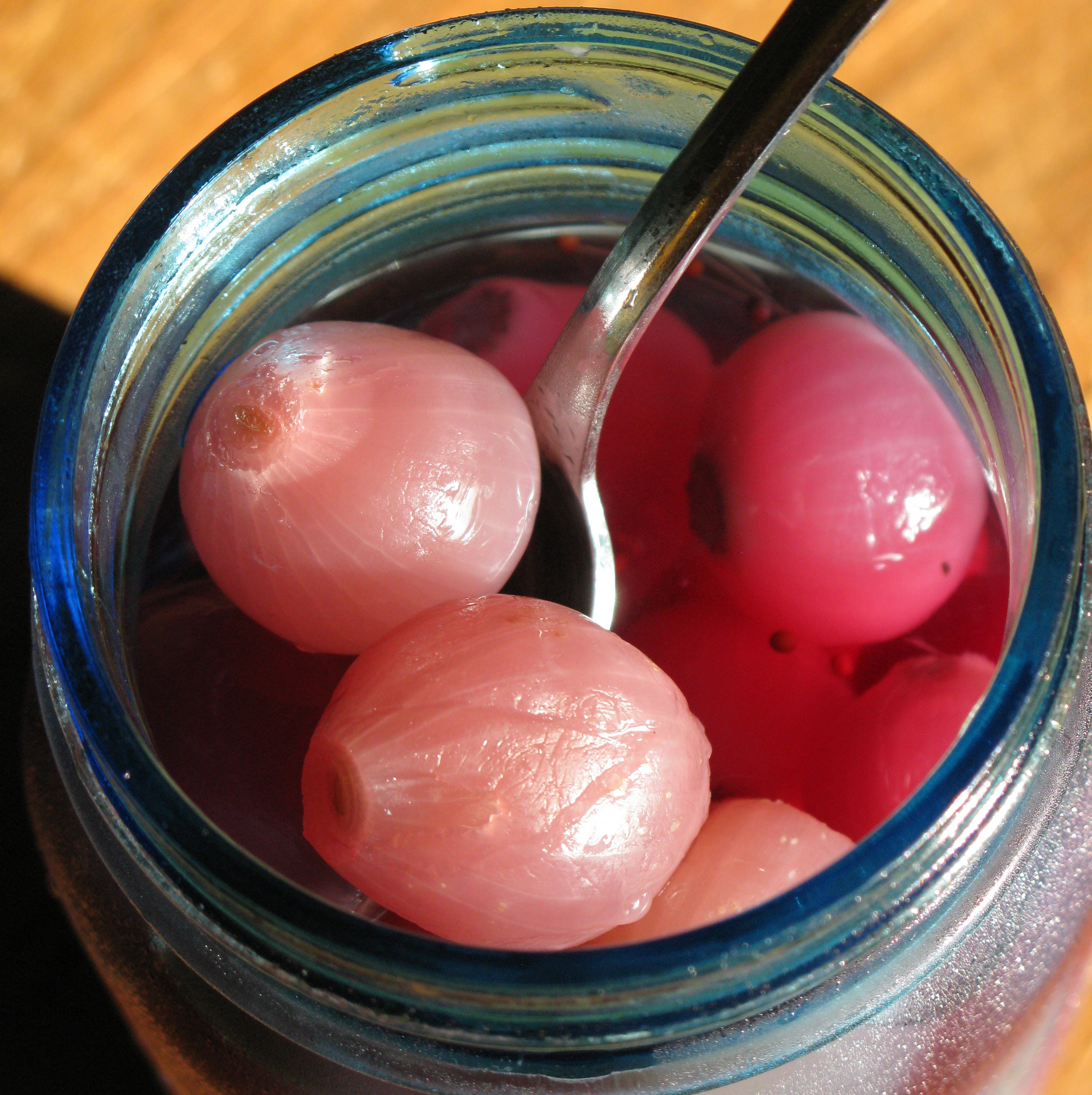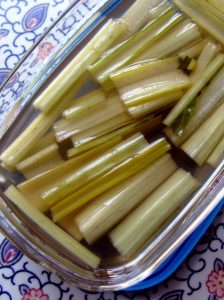Peak tomato season means a grilled Shelburne Farms cheddar sandwich with a few pickles on the side. I made these puckery sweet sour pickled purple baby onions a few months back to serve with pork roast. But now that its peak summer, I realize they go with many summer favorites, including a tomato cheese sandwich. And I use this liquid to make quick refrigerator pickles with the kind of tart sweetness reminiscent of bread and butter pickles.
The blend of vinegar used in the recipe balances the tartness and gives you the freedom to play with the types of vinegar you use. My grandmother Martel made refrigerator pickles using 100% distilled white vinegar. You’d chomp of a pale cucumber spear and gasp from the acidity. No wonder my grandfather could be a real grouch. Best to keep keep the distilled white vinegar for house cleaning.
The acidity of vinegar is listed on the label as a percentage of acidity. Manufacturers determine the percentage of acetic acid in the product to come up with the figure. In the US, vinegar must have at least a 4% acidity. Vinegar is made when the acetobacter bacterium, consumes the sugars in a liquid like cider or wine converting them to acetic acid. You’ll often find this Bacterial ‘mother’ floating is a bottle of unfiltered vinegar such as Bragg’s Apple Cider Vinegar.
A glance at the vinegar in my kitchen tells me that most hover around 5% acidity – apple cider, white vinegar among them. The imported red and white wine vinegar we use and a bottle of commercial malt vinegar are 6% acidity. The rice wine vinegar 4.3%. For the most pleasing taste, I want balanced acidity and sweetness achieved here by using two types of vinegar with different levels of acidity and the right amount of sugar and water.
Here are some Swiss chard stems that I turned into quick pickles using the brine in this recipe.
I am researching ways restaurant chefs promote sustainability. Root to leaf cooking comes up time and again.As we look for ways to curb food waste; finding new uses for stems and greens is front of mind. You can pickle the broad stems of Swiss chard or beets in this liquid. Just cut the stems into one or two-inch pieces, steam them for only a minute to soften them slightly. Place the pieces of stem and greens into the pickling liquid. You can leave this in a jar in the fridge for a week or two. I also like to pickle slices of carrots and English cucumber spears this way.
What to do with pickled greens and stems? Toss them into green salads for a bit of zing. Chop and use them as a garnish on chili and tacos. Stir them into bean and whole grain salads. Dice and stir them into yogurt with fresh mint and other green herbs for a tartar-like dipping sauce.
Kitchen Notebook:
Here’s a terrific article by Linda Zeidrich, author of one of my favorite pickle books The Joy of Pickling that talks about acidity and pickling. The third edition of her book came out this summer.
Versatile Vinegar is the website of the trade association called the Vinegar Institute. I don’t know much about their mission but do find some useful information on their site.

I made these puckery sweet sour pickled purple baby onions a few months back to serve with pork roast. But now that its peak summer, I realize they go with many summer favorites, including a tomato cheese sandwich. And I use this liquid to make quick refrigerator pickles with the kind of tart sweetness reminiscent of bread and butter pickles.
Ingredients
Two 10-ounce bags purple pearl onions
1 ½ cups rice wine vinegar
1 ½ cups cider vinegar
¾ cup water
1 teaspoon fine sea salt
3/4 cup granulated sugar
4 teaspoons mustard seeds
2 teaspoons celery seeds
2 fresh hot chilies such as Thai bird chilies
Directions
- Place the pearl onions in a deep container. Cover them with boiling water and let them site until cool enough to handle. (This softens the skins and makes them easier to peel.) Cut off about 1/8-inch from the stem end and 1/16th of an inch from the root. Peel the onions. This relaxing task is best done while listening to something soothing.
- Wash and rinse two one-pint canning jars. Boil the rings and lids. Let them air dry on a clean dish towel.
- Bring the vinegars, water, salt and sugar to boil in a non reactive saucepan large enough to hold the onions. Allow the mixture to boil for a few minutes to dissolve the sugar. Add the onions. Bring back to a boil. Reduce the heat and simmer the onions until they are just barley tender, for about 5 top 6 minutes.
- Divide the mustard and celery seeds evenly between the two prepared jars. Divide the hot, par-boiled onions evenly between the two jars. Pour the hot pickling liquid over the onions leaving ½-inch of headspace in each jar.
- For longer storage, process in boiling water for 10 to 15 minutes. For short term storage, allow the mixture to cool then store in the refrigerator for up to six weeks.
- Refrigerate the pickles for 5 days to one week before eating.
Notes
Know that most recipes for shelf-stable pickles require vinegar with 5% acidity. I store my small batches of pickled baby onions in the refrigerator so I am not concerned with their shelf life. They last for many months this way.









